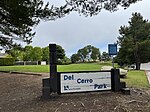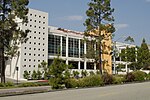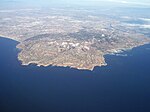Rancho Palos Verdes, California
1973 establishments in CaliforniaCities in Los Angeles County, CaliforniaIncorporated cities and towns in CaliforniaPalos Verdes PeninsulaPopulated coastal places in California ... and 2 more
Populated places established in 1846South Bay, Los Angeles

Rancho Palos Verdes is a coastal city located in south Los Angeles County, California. Incorporated on September 7, 1973, the city has a population of 42,287 as reported in the 2020 United States Census. Rancho Palos Verdes sits atop the bluffs of the Palos Verdes Peninsula, neighboring three other cities in the Palos Verdes Hills, namely Palos Verdes Estates, Rolling Hills, and Rolling Hills Estates.
Excerpt from the Wikipedia article Rancho Palos Verdes, California (License: CC BY-SA 3.0, Authors, Images).Rancho Palos Verdes, California
Oceanaire Drive,
Geographical coordinates (GPS) Address Nearby Places Show on map
Geographical coordinates (GPS)
| Latitude | Longitude |
|---|---|
| N 33.758333333333 ° | E -118.36416666667 ° |
Address
Oceanaire Drive 26
90275
California, United States
Open on Google Maps









